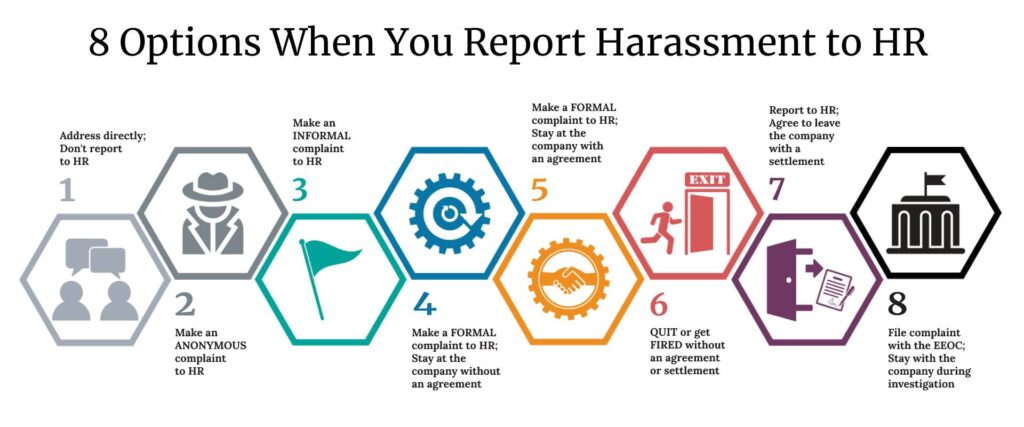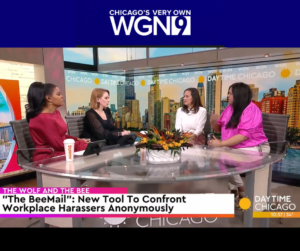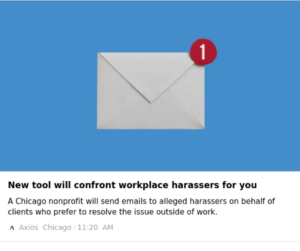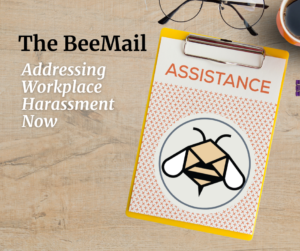Eight Possible Options and Outcomes

Below we have outlined a birds-eye view of your eight possible options when reporting harassment to HR. We’ve included tasks, warnings, outcomes, the effort and energy required, and your overall risk.
Keep in mind:
- Your risk goes up when the harasser has either more seniority or status in the company than you do.
- Even if you do not address the problem, the harassment or discrimination may continue or escalate.
- HR represents the company’s interest first. Finding a resolution that meets the company’s interest may or may not be in your best interest.
Click on each option below to get the full story…
1 – Don’t report to HR; address directly; stay at the company
Tasks:
- Document all past and future incidents, retaliation and costs
- Address the issue directly with the person harassing you; document resolutions
- Consider what to say or do if the behavior continues
Warnings:
- Continued or escalated harassment/discrimination is possible
- Work disruption is possible
Outcomes
- You retain the option to report a complaint to HR at any time
- Filing a complaint with the Equal Employment Opportunity Commission (EEOC) remains an option for a limited time
Efforts and Risks
- Effort: MED
- Overall Risk: LOW-MED
- Job Loss: LOW
- Work Disruption: LOW-MED
2 – Make an ANONYMOUS complaint to HR; stay at the company without an agreement
Some companies have a process that allows you to report a complaint anonymously. Filing an anonymous complaint gives your company a “heads up” that there is a problem to be aware of, and possibly resolve, without triggering a formal investigation. Your company may address the problem with the harasser directly or indirectly. This is a low-risk option for both you and your company, as it gives the company a chance to keep an eye on behaviors.
Tasks
- File an ANONYMOUS complaint
- Continue documentation of all future incidents, retaliation and costs
Warnings
- Work disruption is unlikely
- Continued or escalated harassment/discrimination is possible
Outcomes
- You retain the option to make a formal complaint to HR at any time
- Filing a complaint with the Equal Employment Opportunity Commission (EEOC) remains an option for a limited time
Effort and Risks
- Effort: LOW
- Overall Risk: LOW
- Job Loss: LOW
- Work Disruption: LOW
3 – Make an INFORMAL complaint to HR; stay with the company without an agreement
Some companies have a process that allows you to make an INFORMAL complaint which gives you a chance to put harassment/discrimination on the record without triggering a full scale or formal investigation. Filing an informal complaint gives your company a “heads up” that there is a problem to be aware of that they may resolve without a formal investigation. This is a low-risk option for both you and your company, as it gives the company a chance to keep an eye on behaviors.
HR may quietly investigate, and may add the complaint to the harasser’s file for a pre-defined period of time, to see if additional complaints from you or others are made. If there is more than one complaint, your company may move to a formal investigation process. The company may address or resolve the problem directly or indirectly.
Tasks
- Make an informal complaint to HR
- Continue documentation of all future incidents, retaliation and costs
Warnings
- Work disruption is limited
- Continued or escalated harassment/discrimination is possible
Outcomes
- You retain the option to change your complaint from informal to formal with HR at any time
- Filing a complaint with the Equal Employment Opportunity Commission (EEOC) remains an option for a limited time
Effort and Risks
- Effort: LOW
- Overall Risk: LOW
- Job Loss: LOW
- Work Disruption: POSSIBLE
4 – Make a FORMAL complaint to HR; stay at the company without an agreement
Most companies have a formal complaint and investigation process that puts your complaint on the record. Your HR department will start an investigation into your complaint.
Tasks
- Make a formal complaint to HR
- Continue documentation of all future incidents, retaliation and costs
Warnings
- Formal investigation and work disruption is likely
- Continued or escalated harassment/discrimination is possible
- Employer may find a way to fire complainant after EEOC filing deadlines have lapsed
Outcomes
- Filing a complaint with the Equal Employment Opportunity Commission (EEOC) remains an option for a limited time
- You may file a complaint with the EEOC for retaliation if fired (from fire date)
Effort and Risks
- Effort: HIGH
- Overall Risk: MED
- Job Loss: POSSIBLE
- Work Disruption: HIGH
5 – Make a formal complaint to HR; stay at the company with an agreement
Most companies have a formal complaint and investigation process that puts your complaint on the record. If the investigation finds your complaints to be valid, your company may present you with an agreement that provides protection for the company and you. The agreement should outline the investigation finding and the company’s action to resolve the issue.
Tasks
- Make a formal complaint to HR
- Ensure that the resulting agreement includes checks and balances that provide protections for you
- Continue documentation of all future incidents, retaliation and costs
Warnings
- Formal investigation and work disruptions are likely
- Continued or escalated harassment/discrimination is possible
- Beware of language regarding nondisclosure agreement (NDA) and fault in the agreement
- Employer may find a way to fire complainant after EEOC filing deadlines have lapsed
Outcomes
- The opportunity to file a complaint with the EEOC remains an option for a limited time
- You may file a complaint with the EEOC for retaliation if fired (from fire date)
Effort and Risks
- Effort: HIGH
- Overall Risk: MED
- Job Loss: POSSIBLE
- Work Disruption: HIGH
6 – Quit or get fired without an agreement or settlement; option to file a complaint with the EEOC
Your company may fire you before you file a complaint with HR, or you may decide to quit before you file a complaint, during or after making a complaint with HR, without an agreement or settlement with the company.
Tasks
- Quit and leave the company without an agreement or settlement; or get fired and leave the company without an agreement or settlement
- Find a job and start over with the new company
- Document of all costs of job loss and finding a new job
Warnings
- Job loss
- Costs of finding a new job
- Loss of seniority and seniority benefits when starting over with a new company
Outcomes
- The opportunity to file a complaint with the EEOC remains an option for a limited time
- You may file a complaint with the EEOC for retaliation if fired (from fire date)
Effort and Risk
- Effort: HIGH
- Overall Risk: HIGH
- Job Loss: YES
- Work Disruption: YES
7 – Report to HR; agree to leave the company with a settlement
You may choose to report a complaint to HR and come to an agreement that you will leave the company. With this option, the company agrees to pay a settlement and you agree to terms that limit your legal options regarding your complaint. See more about “Constructive Discharge” HERE.
Tasks
- Report your complaint to HR and come to an agreement with your company that you will leave the company
- Assess your costs to determine a fair monetary settlement
- Consider having an attorney negotiate a settlement on your behalf and/or look over the settlement agreement
Warnings
- Job loss
- Costs of finding a new job
- Loss of seniority and seniority benefits when starting over with a new company
- NDA/gag order likely
- Lose the option to file a complaint with the EEOC or to sue the company
- Company may not admit fault
Outcomes
- Your company is likely to offer you a financial settlement with your severance.
Effort and Risks
- Effort: HIGH
- Overall Risk: HIGH
- Job Loss: YES
- Work Disruption: YES
8 – File a complaint with the EEOC; stay with the company during EEOC complaint process
If your complaint to the company has not been addressed to your satisfaction, you can file a complaint with the EEOC. The EEOC will encourage mediation and settlement. The EEOC process and outcomes generally favor the company.
Tasks
- You must file your complaint with the EEOC within a limited time frame (see important deadlines HERE)
- Assess your costs to determine a fair monetary settlement
- Continue documentation of all future incidents, retaliation and costs
Warnings
- The EEOC complaint process requires a lot of time, effort and energy (minimum of one year)
- It is illegal for the company to fire you if you file a complaint with the EEOC, but it still may occur
- Retaliation by company and/or co-workers is possible
Outcomes
- Filing your claim with the EEOC may expedite a settlement with the company
- If there is no settlement with the company, you may receive a right to sue letter from the EEOC
Effort and Risks
- Effort: HIGH
- Overall Risk: HIGH
- Job Loss: POSSIBLE
- Work Disruption: YES
Get the Latest Buzz
Subscribe to our regular newsletter for the latest news and actions. Your info and time is safe with us!
The Latest News
- Sep 2024 – NewsletterReading Time: 2 minutes The latest news includes a NEW audio feature, a big impact milestone, and a new section of the Navigating Workplace Harassment User Guide.
- March 2024 – NewsletterReading Time: 2 minutes Latest News from the Wolf and The Bee: including our latest media coverage, hitting an impact milestone, a logo glow-up, and new shop items to help you represent!
- Press Coverage: Axios ChicagoReading Time: < 1 minute Axios Chicago Coverage: A Chicago nonprofit is offering a novel service to address workplace harassment: sending cautionary emails to alleged harassers on behalf of unnamed accusers.
- Voyage Utah InterviewReading Time: 3 minutes Voyage Utah: “Discrimination, bullying, and harassment should not be a condition of work. We want to empower each person to make the best decision for where they are in their professional lives and account for their circumstances. “
- Feb-2024 News ReleaseReading Time: 2 minutes NEWS RELEASE: Sexual Harassment ‘Perpetrator’ Targeted by Chicago-Based Non-Profit. Harassment Resource Organization Launches Innovative Program
The Latest Blog
- Silent Sisterhood SurveyReading Time: < 1 minute Silent Sisterhood is conducting an an important study on gender discrimination and we need your voice, experience and insights.






